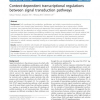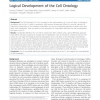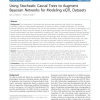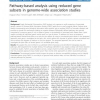BMCBI
2011
13 years 6 months ago
2011
Background: To characterize the diversity of bacterial populations in metagenomic studies, sequencing reads need to be accurately assigned to taxonomic units in a given reference ...
BMCBI
2011
13 years 6 months ago
2011
BMCBI
2011
13 years 6 months ago
2011
Background: We present a novel method to encode ambiguously aligned regions in fixed multiple sequence alignments by ‘Pairwise Identity and Cost Scores Ordination’ (PICS-Ord)....
BMCBI
2011
13 years 6 months ago
2011
Background: Cells coordinate their metabolism, proliferation, and cellular communication according to environmental cues through signal transduction. Because signal transduction h...
BMCBI
2011
13 years 6 months ago
2011
Background: The Cell Ontology (CL) is an ontology for the representation of in vivo cell types. As biological ontologies such as the CL grow in complexity, they become increasingl...
BMCBI
2011
13 years 6 months ago
2011
Background: The combination of genotypic and genome-wide expression data arising from segregating populations offers an unprecedented opportunity to model and dissect complex phen...
BMCBI
2011
13 years 6 months ago
2011
Background: It has been suggested previously that genome and proteome sequences show characteristics typical of natural-language texts such as “signature-style” word usage ind...
BMCBI
2011
13 years 6 months ago
2011
Background: Microarray technology allows the analysis of genomic aberrations at an ever increasing resolution, making functional interpretation of these vast amounts of data the m...
BMCBI
2011
13 years 6 months ago
2011
Background: Time course microarray profiles examine the expression of genes over a time domain. They are necessary in order to determine the complete set of genes that are dynamic...
BMCBI
2011
13 years 6 months ago
2011
Background: Single Nucleotide Polymorphism (SNP) analysis only captures a small proportion of associated genetic variants in Genome-Wide Association Studies (GWAS) partly due to s...




